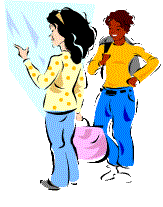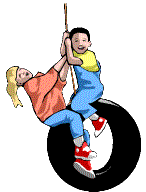Vol. 2, No. 2 • Spring 1998
Interracial Families
by Susan Frey(Names have been changed to protect identity of subjects.)
Parents who adopt transracially cannot ignore that they become a minority family, subject to criticism, odd remarks, and prejudice from people of all races. I remember taking Molly, then three and a half months old, to her first Christmas party. She was immediately surrounded by preschool girls, wanting to look at her and touch her. Then one asked, "Why does she look like that?" referring to the fact that Molly was black and I'm white.
Startled, I launched into an explanation about Molly's birth mother. The 4-year-old looked confused until a friend came to my rescue. "Because she was born that way," my friend said, adding in an aside to me, "That's all you have to say."
Thus, I learned my first lesson in handling insensitive remarks about our unusual family. Besides my daughter, now one and a half, my husband and I also have a 4-year-old son, Joshua, who is part Hispanic. When carpet cleaners came to my home, they first took a look at my two kids, and said, "Oh, you do day care." "No," I replied, "these are my kids." The second surveyed the scene and said, "Foster mother?" Getting warmer. Perhaps the rudest comment came from a Realtor selling a neighbor's home. "Where did she come from?" he asked. What was I supposed to say? Mars?
But there also are advantages. Psychological studies have found that transracially adopted children appear to handle the identity issues all adopted children face better than most because, researchers theorize, they cannot pretend to be like everyone else. They deal with adopting issues before the turbulent teenage years. And children raised in such environments often are able to bridge the culture gap, researchers found. Ben Jones, 20, a junior in political science at Cal State Fullerton, says growing up with white parents, a white sister, a black sister, and two black brothers has helped him get along with both races. "I fit into black and white society," said Ben, an African American. "I think being raised that way helped. I have really good friends, both black and white.
Sometimes, the benefits spill over to white brothers and sisters. Sue, Ben's sister, says she relates easily to people from other cultures. Sue, who married someone from a different race, says her white friends on the Cal State Fullerton campus, where she is getting a master's in clinical psychology, are astonished at how many black people she knows. "I'm always surprised when [a white friend] says she can't talk to somebody. When asked if being part of a multiracial family had any effect on him, David, 13, white, politely said he thought the question was not well thought out. Race, he said, just didn't matter. You must respect people for who they are. "Of course," he continued, in the same tone and with a straight face, "I did have an older brother who was purple. But he died." David made his point.
To get such positive results, parents who adopt transracially have to work a little harder. "They need to be indoor gardeners," according to one transracial adoptee who spoke at a conference of the National Council on Adoptable Children. "When I think of black children, I think of beautiful flowers growing in a garden," he said. "When white people think of black children, they don't always remember the garden they came from. They only see the flower already picked and ready to go in a vase somewhere in their house to enjoy and to look pretty." He said picked flowers are disappointing because they wilt and dry up. "I guess what I'm saying is I'd rather be a gardener in natural surroundings than a florist in an artificial setting," he said. "The way I see white parents with black kids is they're doing the best they can. They're sort of indoor gardeners. I won't work with florists, but I'll work with indoor gardeners."
The first place one needs to begin working is with oneself. *Joan of Los Altos says her greatest surprise after she adopted two black children was facing her own racism. "I was raised as a white liberal and was not prejudiced in obvious ways," Joan said. "I never realized [my racism]. It was rather shocking and embarrassing."
A college graduate, who asked not to be named, had a similar experience. An Hispanic who grew up in a predominantly white neighborhood, he remembered feeling out of place as a child and being referred to negatively as an Indian. When he adopted his daughter, who was black, she looked to him even darker, like an Indian. He felt embarrassed and frightened. "When I was a child, I felt trapped by how I looked," he said. "There was nothing I could do about it. Looking at my daughter, I felt fear for myself and fear for her. But it disappeared when I could express my anger." Besides dealing with their own racism, parents also need to help their children identify with their race. Research studies have shown that transracially adopted children sometimes identify with their parents' race rather than their own. "Culture is passed on by families," the conference speaker said. "That's one of the functions of families. Black children need black adults in order to learn black culture." Patty King, adopted by white parents, grew up in Gilroy in a multiracial family. She was the only black child in her elementary school. King, a very lightskinned black and an extrovert, had little trouble fitting in. In fact, for her, race was such a non-issue that when a child made fun of her for not looking like her mother, the petite King got mad at her mother for being "too tall." But after she left the security of her home and community, she found she had trouble being accepted by both races. Her white husband would not take her home to the South to meet his family. Black people accused her of being an Oreo--black on the outside and white within.
Organizations such as Interracial Pride, a Northern California support group for interracial families, have sprung up to help transracially adopted children such as King and children born of mixed marriages. Besides belonging to such organizations, white parents need to live in mixed neighborhoods, send their children to mixed schools, and cultivate friends of the same race as their children. And parents who adopt more than one child would be wise to choose children from the same racial background, those in the adopting field say. Cultural identity can become less of an issue, and the children can support each other. Norma--with four black teenagers--became the hub of what was happening at her children's high school. All three of her sons were homecoming kings, she said. "Teenagers force their lives on the people around them," she said. "You're bathed in black popular culture."
Copyright � 2000 Jordan Institute for Families



